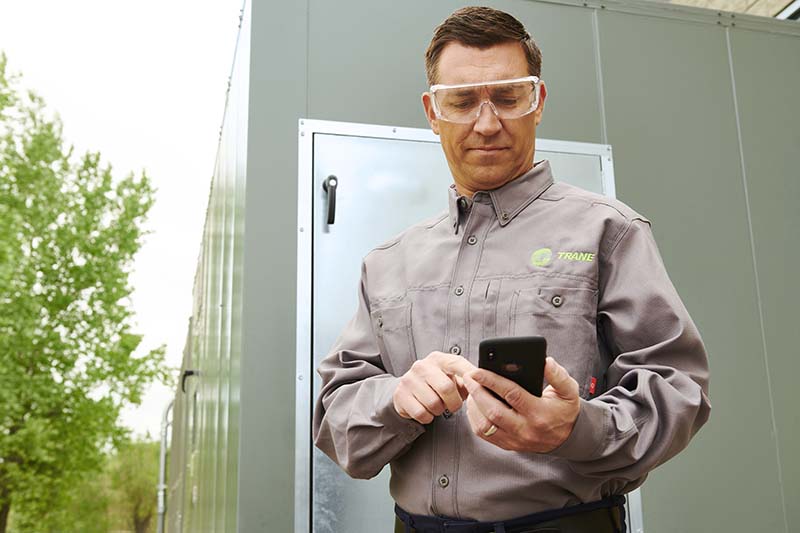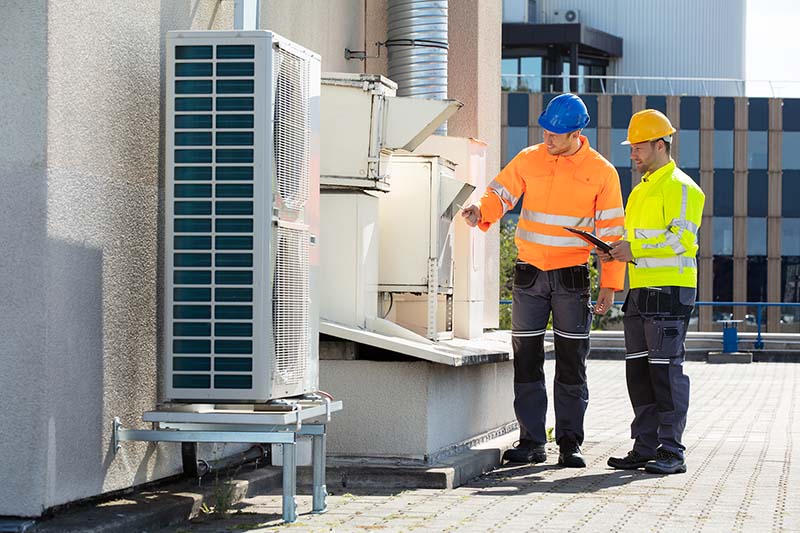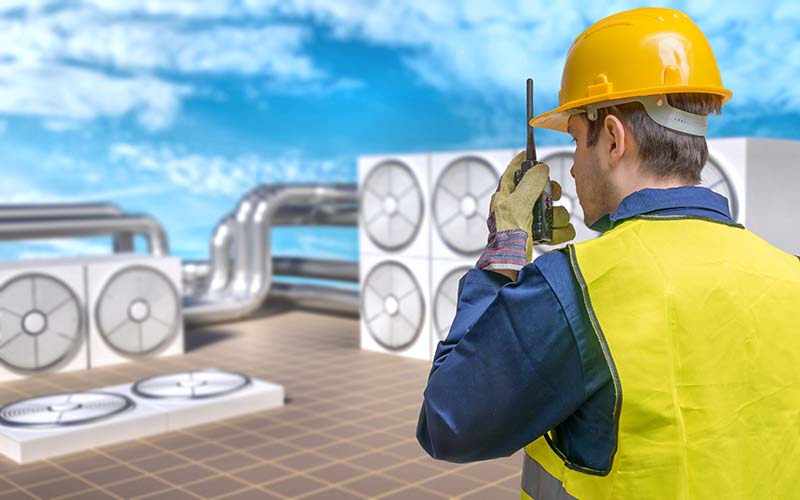Artificial intelligence (AI) is one of the most promising — and exciting — technologies to come to the HVACR industry in a long time, and manufacturers are wasting no time in researching how it can be incorporated into their equipment. What makes AI so exciting is that it has benefits for virtually everyone, from the OEM to the contractor to the end user to the building occupant.
For OEMs, an AI-enabled rooftop unit or chiller could allow the collection of massive amounts of real-time data that could be used to improve the design of a product or optimize its operation. For contractors, AI predictive modeling could foresee when a breakdown may occur, giving them time to fix the problem before it results in downtime. And the repair would be faster because the system would likely be able to diagnose itself.
For building owners and occupants, an AI-enabled HVAC system would continuously monitor and analyze conditions inside the space, as well as outdoors, and constantly make adjustments to the environment based on the data being collected. This could lead to not only more comfortable occupants but also lower energy bills for building owners.
Exciting Possibilities In AI And Chillers
While there is much excitement about all the opportunities that AI can offer, the HVAC industry is still somewhat early on in how widely, and how well, it is applying AI, said Anthony Trifiletti, director, services portfolio, Trane Commercial HVAC Americas.

WELL CONNECTED: Trane is using AI across its connected building and equipment portfolio, which is fast approaching 20,000 connected buildings and one million pieces of connected equipment in those systems.
“When new AI opportunities are introduced to various industries, there is a curve of adoption – with the HVAC business tending to be somewhat late adopters,” he said. “AI can run the gamut from a simple regression model all the way to deep reinforcement learning, where the AI is dynamically learning all the time — which is really where we are headed as an industry. We have made significant strides in the AI space but certainly have more to go with the continuous expansion of new technology.”
That said, Trane is using AI across its connected building and equipment portfolio, which is fast approaching 20,000 connected buildings and one million pieces of connected equipment in those systems, said Patrick Tonker, commercialization strategy leader, Trane Commercial HVAC Americas.

DETECT AND DIAGOSE: At Trane, AI takes the form of advanced analytics and robotic process automation, which allow the ability to automatically detect and diagnose issues that could impact customers’ buildings.
“Today, AI takes the form of advanced analytics and robotic process automation that allows us to automatically detect and diagnose issues that could impact our customers’ buildings – spotting evaporator heat transfer issues or improper outside air damper operation, for example,” he said.
Trane thinks of AI in terms of overall systems, said Tonker, which means looking at not just the equipment, but the entire building and its automation system. While predicting and/or discovering issues are key factors in AI, the real opportunity lies in the optimization of the entire system — applicable to both chillers and rooftops, he said.
By providing continuous, dynamic optimization for customers and their buildings, Trane is harnessing the power of AI, using machine learning, to keep the human operator in the loop but reducing the need for decision making, said Tonker. This allows for more consistent performance, productivity gains, and a reallocation of resources to more value-added tasks.
“A customer may not know that AI is deployed as they are most interested in the results; we recognize the value from the facility team as local subject matter experts — and they are part of the overall solution,” he said.
Daikin Applied is also researching how to best utilize AI in its chillers and rooftops, and some of the analytics used in their Intelligent Equipment (IE) Solutions already have AI built into them, said Mike Schwartz, CEO of Daikin Applied.
“I’m convinced that as we go forward, these AI-enabled analytics will have the ability to condense down a lot of data into usable, valuable actions,” he said. “For service technicians, AI will be able to give them direction on what they need to do to fix the unit. For building owners and operators, they will be able to pull out a cell phone and find out exactly how the units are operating and how much energy they’re consuming.”
The service aspect is particularly useful, said Schwartz, as contractors will be able to monitor a customer’s equipment remotely and be alerted if the system detects a problem. Then the service technician could be dispatched to the customer’s site to fix the issue before the customer even knows about it.
“This type of technology is going to be extremely powerful for customers, which is why we see it expanding exponentially in the future,” he said.
AI will definitely make life easier for both contractors and end users, noted Tonker. Contractors will appreciate the predictive modeling that AI can offer, which will provide a boost to their preventive maintenance business. AI will also make the installation and start-up process easier, as well as help manage warranty calls and aftermarket parts and supplies.
“From an end user perspective, we think of four main performance categories that define potential customer benefits: comfort, energy savings, reliability, and compliance,” he said. “These are levers that different customers need to pull to varying degrees depending on their operational profile and objectives. At the end of the day, the point of using AI at Trane is to connect the performance of our customers’ buildings to their business results.”
Automated Intelligence Can Solve Problems
Having the ability to continually manage and monitor HVAC equipment, including chillers and rooftops, is one of the main benefits of AI, said Dr. Barry Po, president of connected solutions at mCloud Technologies, a provider of asset management solutions that utilize AI and analytics for enhanced energy efficiency and building air quality.
“What if you had somebody who could pay attention to the equipment 24 hours a day, seven days a week, nonstop?” he asked. “How would that change the way in which building owners manage their chillers and boilers? And how would you then be able to respond to issues before they become serious?”
That is how AI creates value, said Po: building owners are able to have their assets intelligently managed via limitless computing in the cloud to eliminate unexpected downtime and equipment replacement while optimizing their total cost of ownership (TCO). This lies in contrast to what usually occurs today, which is that contractors conduct scheduled maintenance checks that may miss issues between visits or are simply summoned when the equipment fails.
“The great opportunity of AI is the ability to take existing assets and better manage them with zero changes to the HVAC system design or the need for special on-site hardware,” he said. “AI gets eyes on the assets. That way, owners and operators can focus on more pressing issues.”

REMOTE MONITORING: 75F Facilisight offers allows portfolio-wide building automation with remote monitoring and management.
Maintenance is one of those issues that owners and operators would rather not worry about, and AI-enabled equipment will drive improvements in this area that will enhance cost savings and production value, said Deepinder Singh, CEO and founder of 75F, which uses smart sensors and controls to make buildings more comfortable and efficient.
“With AI, there is now the ability to process massive amounts of sensor data faster than ever before,” he said. “What this does is gives companies a chance to improve their existing maintenance operations and possibly add something new: predictive maintenance. Using AI to prevent faults inherently leads to a second benefit: creating a more comfortable environment for tenants. Humans are the ultimate sensor within a building, and companies are actively trying to find ways to personalize comfort for their occupants within a shared workplace.”
Trends in Automated Intelligence
There is no question that AI is a big breakthrough in technology, said Po, and the goal now is to get more people on board.
“People continuously talk about how innovation in HVAC equipment comes from building better hardware, but I think that completely misses the boat,” he said. “We don’t need better engineering — there’s a point where you can only make an HVAC unit so efficient. The real potential is in optimizing unit performance through better management and improved software.”
And as more OEMs incorporate AI into their HVAC equipment, there will be a trend towards deeper integration of controls with their equipment as they seek to optimize performance and maximize value to their customers, said Singh.
“The integration of AI into chiller and rooftop controls has already begun, and we expect AI to be a feature of the majority applied equipment sales within three years and standard offering for all sales in five to seven years,” he said.
Indeed, there is a lot of interest in AI right now, especially how the technology can be used to improve the performance of rooftops and chillers, said Tonker.
“I don’t believe customers wake up saying, ‘I want to buy an AI chiller today,’ but they certainly wake up thinking, ‘I wish I had more people to run my buildings and more ways to understand how and when to optimize the performance of my buildings,’” he said. “Those are the types of solutions end users are looking for, which AI can deliver.”





Report Abusive Comment